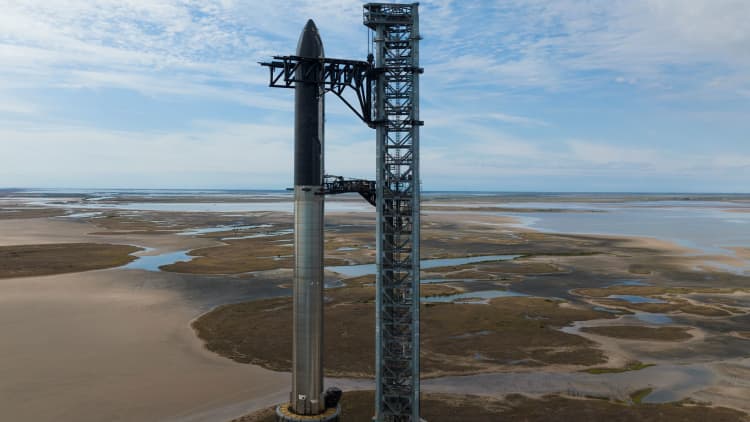
SpaceX Starship lifted off from Starbase near Boca Chica, Texas, on November 19, 2024, for the Starship 6 flight test.
Chandan Khanna | AFP | Getty Images
SpaceX launched Sixth test flight The company unveiled its Starship rocket on Tuesday as it looks to keep momentum developing the behemoth.
The rocket took off from SpaceX’s private “Starbase” facility near Brownsville, Texas. There was no one on the Starship flight.
The Starship reached space and flew half a circle around the Earth before reentering the atmosphere and crashing into the Indian Ocean.
SpaceX’s goal is to return the rocket’s Super Heavy booster after it separates from Starship and land it on the arm of the company’s launch tower. But SpaceX said in its webcast that the booster did not specify the “submission criteria” required for the capture attempt, so the booster instead landed in the Gulf of Mexico.
As with every previous test flight, SpaceX is furthering development by testing additional capabilities for Starship, including reigniting its engines in space and testing new elements of its heat shield.
Additionally, the evening launch time means this is the first time a Starship has splashdowned in the Indian Ocean during the day.
On November 19, 2024, U.S. President-elect Donald Trump watched Elon Musk explain the operations of the sixth test flight of the SpaceX Starship rocket in the control room in Brownsville, Texas.
Brandon Bell | Getty Images
Challenge the limits
On October 13, 2024, SpaceX captured the first-stage “Super Heavy” booster of its Starship rocket.
Sergio Flores | AFP | Getty Images
Since April 2023, SpaceX has conducted six aerospace tests of the complete Starship rocket system, with the frequency of testing steadily increasing. Its releases last month included Dramatically catching a rocket’s booster more than 20 stories high for the first time.
After the success of the fifth flight, the Federal Aviation Administration confirmed that SpaceX has been authorized to move forward with the sixth flight.
On November 19, 2024, the SpaceX Starship rocket conducted its sixth test flight in Brownsville, Texas, USA.
Brandon Bell | Reuters
But, like previous test flights, the fifth launch was not without incident. SpaceX management revealed in audio posted by Musk on social media after the launch that Starship’s booster nearly missed capture due to a timing issue with one of the rocket’s subsystems.
“We were one second away from tripping up and telling Rocket to abort and try to hit the ground next to the tower instead of (landing on) the tower – like mistakenly telling a healthy Rocket not to try to catch the ball,” an unidentified person said. person told Musk in the audio.
SpaceX did not catch the booster again. The company said on its website that it made hardware upgrades to the rocket booster to increase redundancy and improve structural strength.
Starship systems are designed to be fully reusable and intended to be a new way to transport cargo and people beyond Earth. The rocket is also critical to NASA’s plans to return astronauts to the moon. SpaceX won a multibillion-dollar contract from the agency to use Starship as a crewed lunar lander as part of NASA’s Artemis lunar program.
Starship is the tallest and most powerful rocket ever launched. Starship, fully stacked on Super Heavy boosters, is 397 feet tall and about 30 feet in diameter.
The Super Heavy booster is 232 feet tall and is the starting point for the rocket’s journey into space. There are 33 Raptor engines on its base, producing a total of 16.7 million pounds of thrust, about twice the 8.8 million pounds of thrust of NASA’s Space Launch System rocket, which first launches in 2022.
The starship itself is 165 feet tall and has six Raptor engines – three for use in Earth’s atmosphere and three that operate in the vacuum of space.
The rocket is powered by liquid oxygen and liquid methane. The entire system requires more than 10 million pounds of propellant to launch.







